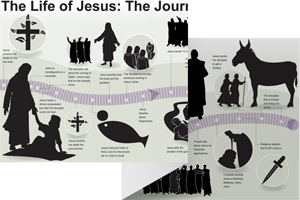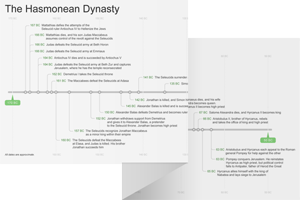10:1–42 In His final public address, Jesus continues teaching and uses another “I am” saying with a metaphor (see note on John 6:35) to explain His identity as Messiah. Jesus uses the imagery of the good shepherd (v. 11), which should be understood in the light of ot passages that criticize Israel’s shepherds (a metaphor for their kings) who have failed in their duty (Jer 23:1–8; Zech 11:4–17; Isa 56:11; Ezek 34:1–31). The remedy for the failure of the shepherds in many ot passages is that God Himself takes on the role of the shepherd of Israel (compare Pss 23:1; 80:1; Isa 40:10–11). At the same time, God promises to raise up another shepherd for Israel who will lead His people properly (Ezek 34:23). Jesus depicts Himself in that messianic role of the ideal shepherd. He is both the shepherd who lays down His life for the sheep (John 10:11) and the gateway to eternal life (v. 7). |
 The Parable of the Good Shepherd Devotional
The Parable of the Good Shepherd Devotional
10:1 Truly, truly See note on 1:51.
the fold of the sheep This was a courtyard surrounded by a stone wall. If it had a gate, there was usually a gatekeeper guarding it (v. 3) who would know which shepherds had legitimate business there. Several families might use the same sheep pen.
10:3 he calls his own sheep by name Distinguishing them from other sheep that might be in the same fold. The point is that sheep follow the right shepherd.
10:6 this parable See note on Matt 13:3.
they did not understand The audience misses the symbolism of the parable. Just as sheep recognize their shepherd and follow him, so those who truly belong to Jesus will recognize Him and follow Him.
10:7 I am the door of the sheep Jesus is the gateway for eternal life as well as the one who leads the sheep (compare note on John 6:35).
 Jesus’ ‘I Am’ Statements Table
Jesus’ ‘I Am’ Statements Table
10:8 thieves and robbers Highlights the misleading ministry of previous generations of Israel’s leaders who had been leading them astray. See note on Ezek 34:1–10.
10:10 may have life, and have it abundantly See Ezek 34:25–31 and note (compare Ezek 34:12–15).
10:11 I am the good shepherd Jesus fulfills the messianic role of the shepherd. This role in Ezekiel is depicted as fulfilled by God; Jesus makes the claim that He (as God in flesh) is the one fulfilling it (see note on Ezek 34:23). On the “I am” saying, see note on John 6:35.
 The Parable of the Good Shepherd Devotional
The Parable of the Good Shepherd Devotional
 Jesus’ ‘I Am’ Statements Table
Jesus’ ‘I Am’ Statements Table
lays down his life Evoking imagery of the young shepherd, David, risking his life to keep his sheep safe (see 1 Sam 17:34–37). In addition to fulfilling God’s role with His people as shepherd, Jesus fulfills David’s role as their king.
10:15 the Father knows me This gives Jesus the authority to make the claims He does. Compare Matt 11:27.
10:16 I have other sheep Alluding to the Gentiles and the ultimate universal scope of salvation via Christ’s atoning death. Compare Isa 56:8.
one flock—one shepherd Compare Ezek 34:23. The flock includes all believers, both Jews and Gentiles.
10:19 a division among the Jews See John 9:16 and note.
10:20 He has a demon See note on 7:20; compare 8:48.
10:21 A demon is not able It was believed that only God Himself had the ability to overcome blindness. See Psa 146:8.
10:22 feast of the Dedication Refers to the feast of Hanukkah, celebrated to commemorate the rededication of the temple.
 Israelite Festivals Table
Israelite Festivals Table
Israelite Feasts in John’s Gospel | |
Passover (3 different years) | |
feast of the Jews | |
Tabernacles | |
Dedication (Hanukkah) | |
10:23 the Portico of Solomon A covered walkway on the eastern side of the Court of the Gentiles in the temple complex.
10:24 the Jews Here referring to the crowd in general, not the religious leaders. See note on 1:19.
10:25 the name of my Father See 5:36 and note.
10:30 The Father and I are one Understood by the audience as an allusion to Deut 6:4 and a claim to divinity. See John 10:36 and note.
10:31 the Jews picked up stones again Compare 8:59 and note.
10:34 your law See note on 8:17. Here, Jesus refers collectively to the Hebrew Scriptures.
You are gods A quotation of Psa 82:6, which refers either to the divine council or to human judges as God’s representatives administering justice on earth.
10:36 I said, ‘I am the Son of God In addition to subtle allusions to His divine nature, Jesus has explicitly identified Himself as the Son of God (John 5:25).
10:39 were seeking again to seize him Compare John 7:30, 44.
departed out of their hand See note on 7:6.
10:40 other side of the Jordan Jesus leaves Jerusalem and goes to the wilderness east of the Jordan.

|
About Faithlife Study BibleFaithlife Study Bible (FSB) is your guide to the ancient world of the Old and New Testaments, with study notes and articles that draw from a wide range of academic research. FSB helps you learn how to think about interpretation methods and issues so that you can gain a deeper understanding of the text. |
| Copyright |
Copyright 2012 Logos Bible Software. |
| Support Info | fsb |
 Loading…
Loading…


 after the
after the 